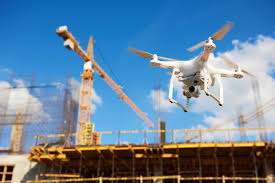
Advancing Construction Technology: Innovations Shaping the Future of Building
The Evolution of Construction Technology
Construction technology has undergone significant advancements in recent years, revolutionizing the way buildings and infrastructure are designed, constructed, and maintained. From innovative materials to cutting-edge tools and techniques, the construction industry is embracing technology to improve efficiency, sustainability, and safety.
Building Information Modeling (BIM)
One of the most notable developments in construction technology is Building Information Modeling (BIM). BIM allows architects, engineers, and contractors to create detailed 3D models of buildings and infrastructure projects. These models not only provide a visual representation of the project but also contain valuable data about materials, costs, schedules, and more. BIM enables stakeholders to collaborate more effectively, identify potential issues early on, and optimize the design and construction process.
Robotics and Automation
Robots and automation are increasingly being used in construction to perform repetitive tasks more efficiently and accurately. Robots can be used for tasks such as bricklaying, concrete pouring, welding, and demolition. By automating these tasks, construction companies can increase productivity, reduce labor costs, and improve safety on the job site.
Augmented Reality (AR) and Virtual Reality (VR)
Augmented Reality (AR) and Virtual Reality (VR) technologies are transforming the way architects and engineers visualize projects before they are built. AR allows users to overlay digital information onto the physical world in real-time, while VR creates immersive virtual environments that users can explore. These technologies enable stakeholders to experience a project in a more interactive way, identify design flaws early on, and make informed decisions throughout the construction process.
Sustainable Construction Materials
The construction industry is increasingly focused on sustainability, with a growing emphasis on using environmentally friendly materials. Sustainable construction materials such as recycled steel, bamboo flooring, green concrete made from industrial byproducts like fly ash or slag are gaining popularity due to their reduced environmental impact. These materials not only help reduce carbon emissions but also contribute to energy efficiency in buildings.
Drones
Drones are being utilized in construction for surveying land areas, monitoring project progress from aerial views, inspecting structures for damage or defects without risking human lives. Drones provide accurate data quickly that can help project managers make informed decisions about resource allocation.
In conclusion, construction technology continues to evolve rapidly with new innovations shaping the future of the industry. By embracing these technological advancements such as BIM,
robotics,
AR/VR,
sustainable materials,
and drones,
the construction sector is poised to become more efficient,
sustainable,
and safe than ever before.
These advancements promise to revolutionize how we build our cities
and infrastructure for generations to come.
Understanding Key Aspects of Modern Construction Technology
- What are the four types of construction technology?
- What is the latest technology in building construction?
- What are at least three common technologies used in construction?
- What is construction in technology?
What are the four types of construction technology?
In the realm of construction technology, there are four main types that play crucial roles in shaping the industry’s landscape. The first type is Building Information Modeling (BIM), a powerful tool that enables stakeholders to create detailed 3D models of projects, enhancing collaboration and efficiency. Robotics and automation represent another type, revolutionizing construction by automating tasks like bricklaying and welding to boost productivity and safety. Augmented Reality (AR) and Virtual Reality (VR) technologies offer immersive experiences for visualizing projects before construction begins. Lastly, sustainable construction materials such as recycled steel and green concrete are gaining traction, emphasizing environmental consciousness in building practices. These four types of construction technology showcase innovation and progress in the field, driving advancements in efficiency, sustainability, and safety.
What is the latest technology in building construction?
The latest technology in building construction encompasses a wide range of innovations that are transforming the industry. From advanced Building Information Modeling (BIM) software that enables precise project planning and collaboration to the use of robotics and automation for tasks like bricklaying and welding, the construction sector is embracing cutting-edge tools and techniques to improve efficiency and productivity. Augmented Reality (AR) and Virtual Reality (VR) technologies are also revolutionizing the way architects visualize projects, allowing for immersive experiences and early identification of design flaws. Sustainable construction materials, such as recycled steel and green concrete, are gaining traction for their environmental benefits. Overall, the integration of these technologies is reshaping how buildings are designed, constructed, and maintained in today’s rapidly evolving construction landscape.
What are at least three common technologies used in construction?
In the realm of construction technology, there are several common technologies that have become integral to modern construction practices. Three frequently utilized technologies include Building Information Modeling (BIM), which enables stakeholders to create detailed 3D models of projects for enhanced collaboration and efficiency; Robotics and Automation, which streamline repetitive tasks like bricklaying and welding to boost productivity and safety on job sites; and Drones, which are employed for surveying, monitoring progress, and inspecting structures from aerial perspectives, providing valuable data for informed decision-making in construction projects. These technologies represent just a fraction of the innovative tools shaping the construction industry today.
What is construction in technology?
Construction in technology refers to the application of advanced tools, techniques, and processes to design, build, and maintain structures and infrastructure. It encompasses the use of innovative materials, automation, digital modeling, and other cutting-edge technologies to enhance efficiency, sustainability, and safety in the construction industry. By leveraging technology such as Building Information Modeling (BIM), robotics, augmented reality (AR), sustainable materials, and drones, construction professionals can streamline project workflows, improve collaboration among stakeholders, reduce costs, and ensure high-quality outcomes. Construction technology plays a pivotal role in shaping the future of the built environment by driving progress and innovation in how buildings and infrastructure are conceptualized, constructed, and managed.



